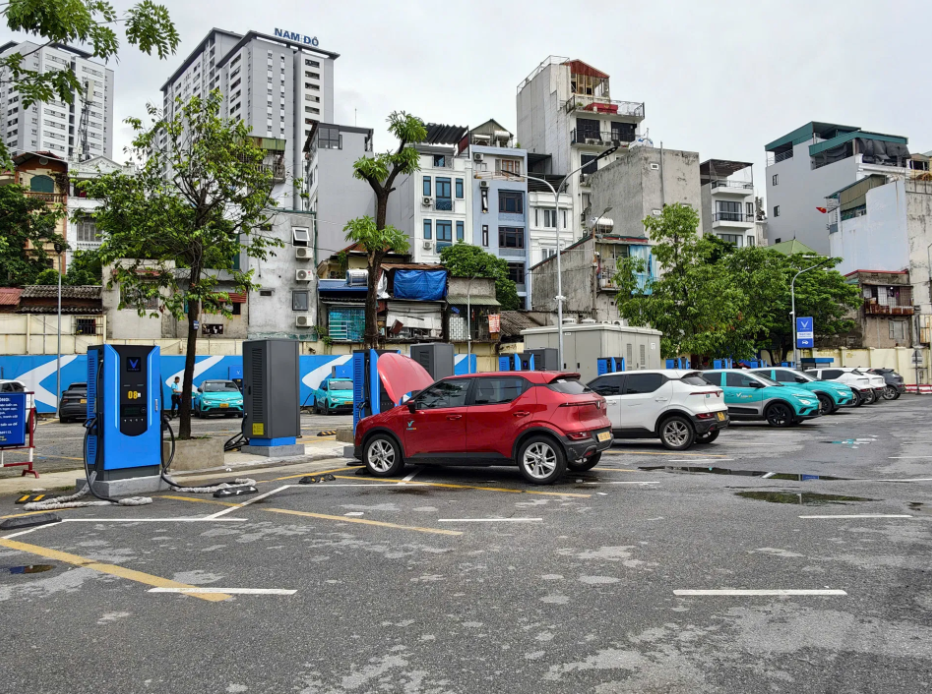Hanoi rolls out more EV chargers at major bus terminals
Several electric vehicle charging stations have recently been launched at bus terminals throughout Hanoi as part of the city government’s green transition initiative.
Hanoi has opened its first electric car charging stations at major bus terminals, marking a new step in the city’s shift from gasoline to green transport.

Area designated for electric vehicle charging at Giap Bat Bus Station, Hanoi. Photos: Pham Cong/The Hanoi Times
Three major bus terminals in Hanoi, including Giap Bat, Gia Lam, and Yen Nghia, have officially launched electric car charging stations, with Giap Bat hosting the largest facility.
Spanning more than 500 square meters, the Giap Bat terminal features 20 charging poles and 40 ports, each with a capacity of 120 kW, enabling most cars to recharge in just 30 to 40 minutes.
Deputy Director Giap Bat Bus Terminal Ta Anh Tuan said that installation at Giap Bat began in early June and was completed by June 10, when the first electric vehicles started using the station.
“With a charging capacity of 120 kW per pole, a typical 5- to 7-seat car takes only 30 to 40 minutes to charge. Since its launch, Giap Bat has consistently seen high demand, especially at night,” said Tuan.
Gia Lam Bus Terminal is also rolling out more than 30 charging ports, with encouraging initial results.
Deputy Director Nguyen Manh Tuan of Gia Lam Bus Terminal said that the terminal worked with equipment providers to install the station on vacant land, aiming to serve the growing demand for electric vehicles.
“The chargers have operated effectively from the start, and passenger volume has shown steady growth," said Tuan.
Nguyen Ba Long, a taxi driver living in Hoang Mai Ward, said: “Having charging stations at bus terminals is very convenient. We can charge while waiting for passengers, and there are resting areas while the cars are plugged in.”
At My Dinh and Nuoc Ngam bus terminals, management units are studying space allocation to soon begin construction of charging stations. Locations must ensure adequate area, convenience for users, and no disruption to passenger pick-up and drop-off. Installations at these terminals are expected to be completed in 2025.
Earlier, the Hanoi Department of Construction instructed bus terminal operators, parking lot managers, vehicle registration centers, and transport businesses to set up charging facilities for electric and clean-energy vehicles and report their progress.
Operators were told to review potential sites under their management and submit installation plans, while transport companies must detail their transition to clean vehicles and the development of charging stations at depots and parking areas.

More than 30 electric vehicle charging ports are being installed at Gia Lam Bus Terminal.
On July 12, under Directive No. 20 on urgent measures to address pollution, Prime Minister Pham Minh Chinh instructed Hanoi to accelerate the transition so that, by July 1, 2026, no fossil-fuel motorcycles or scooters will circulate inside Ring Road 1.
From January 1, 2028, fossil-fuel cars will also be restricted inside Ring Roads 1 and 2, and by 2030, the ban will apply within Ring Road 3.
Ring Road 1 forms a closed loop through major streets such as Tran Khat Chan, Dai Co Viet, De La Thanh, Buoi, Cau Giay, Vo Chi Cong, Nghi Tam, Yen Phu, and Tran Quang Khai.
The route is about 25 kilometers long, covering 31 square kilometers, with West Lake accounting for 5.2 square kilometers. The area includes nine wards after administrative restructuring, with a population of about 600,000 and nearly 450,000 registered motorcycles.
To meet the 2026 target, Hanoi aims for at least 10% of existing parking spaces inside Ring Road 1 to be equipped with charging poles by the end of that year, while new projects will be required to allocate 30%. The city also plans to prioritize chargers on sidewalks and encourage investment in hydrogen and other clean-fuel stations.








